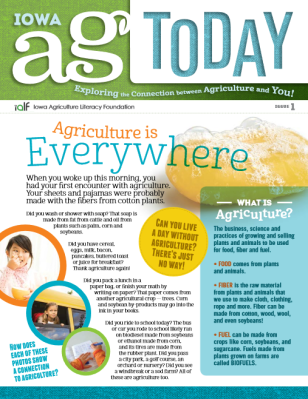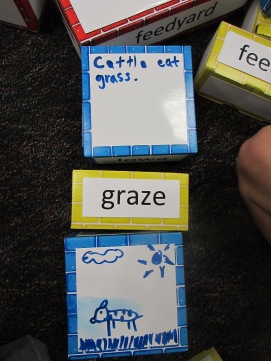The Iowa Agriculture Literacy Foundation has multiple publications available for teachers to use in their classrooms. One set of publications are the Iowa Ag Today magazines, with a set of six available at a fourth-grade reading level, and a set of two (so far) at a seventh-grade reading level. Another set of publications are the My Family’s Farm books written at a third-grade reading level. These materials are high quality, aligned to standards, and come at little to no cost to the teachers. In this blog, I’ll walk you through some suggestions for how to use these publications in a classroom. I hope you’ll find some good ideas!
Iowa Ag Today
The Iowa Ag Today publications are a great series of fourth grade and middle school non-fiction readers. The fourth-grade series contains six cross-curricular magazines, and the middle school series contains a social studies magazine and has a brand new science magazine in the works. We also recently translated the first three fourth-grade readers to Spanish, and have those available for Spanish teachers and ELL teachers, as well. When a new magazine comes out, it is directly mailed to each fourth-grade teacher, seventh-grade teacher, or ELL teacher to which it corresponds. But what should these teachers do with them when they arrive?

Issue 1 of the fourth grade Iowa Ag Today covers what agriculture is, and how it impacts all of us.
Check out the teacher guide
With each pack of 25 readers, there is a teacher guide that includes discussion questions, vocabulary and definitions, a worksheet, extension ideas, and a pre/post-test. This handy guide, complete with standards alignment, is a great starting point to help you integrate the readers into your classes.
Many of these things can be structured differently depending on your students and the goals of your class. Maybe it would work better for your students to start off with vocabulary words and discussion questions so they are prepared for the reading. Maybe it would work better for your students if those things were brought up as they are reading about them.
Use them for group reading
Help students with the skill of reading aloud by reading articles together as a class or in pairs or small groups. Refer to the discussion questions and vocabulary definitions in the teacher guide to help deepen comprehension with each article.
Analyze extra features
Iowa Ag Todays are full of pictures, charts, graphs, maps, discussion questions, and more. Guide your students through each of these features and help them learn to interpret them.

This centerfold is a great example of the types of graphics in Iowa Ag Today magazines. Lots of time can be spent analyzing this map!
Use K/W/L charts for certain topics
Iowa Ag Todays cover lots of different topics. Choose an idea or article you’d like your students to learn more about and create K/W/L charts either individually or as a class. If not all of their questions are answered, the students could continue their learning with research projects!
Mark ‘em up!
One of the great parts about magazines is that they can be written on. Though you can keep these readers from year to year, you can also have your students use pens or fine-point markers to note parts of speech, questions they have, main ideas, or other in-text features!
Many teachers do what’s called “thinking tracks.” With this method, you can have different symbols for different reactions, like questions, predictions, connections, new learning, and main ideas. These symbols can be shapes, letters, squiggles, or even marks with different colored pens!
Think cross-curricular
Each fourth-grade Iowa Ag Today is aligned with standards across curricula, including Iowa Core English Language Arts, science standards, and social studies standards. These magazines could fit into any (or all!) of these class periods, to help students learn about science and social studies while learning how to interpret non-fiction text.
Go with the flow
You may have the opportunity to let some exploration happen organically! After reading articles and answering discussion questions, see what types of things your students find interesting. Maybe they want to learn more about drones or manure used as fertilizer. This can be an opportunity to search out videos, extra information, or allow your students to make presentations and reports.
Remember, IALF has many resources available to you. If your students get interested in a certain topic, check to see if there is a lesson plan covering it on our website. Check our YouTube channel to see if we’ve linked a video about it in a playlist. Search our blog for further background knowledge on the topic. And if you are still stuck, send us an email for more ideas!
My Family’s Farm
My Family’s Farm is a series of books written at a third-grade level about young Iowans’ home farm operations. These books include modern pictures and examples, a vocabulary and definitions section, and have two standards-aligned lesson plans that correspond to them. At this time, there are My Family’s Farm books about a beef, corn, soybean, wind, and pig farm. In the future, this series will also include books on an apple farm and an egg farm!
When a new book is published in this series, one copy of the book is sent to each third-grade teacher in the state of Iowa. How should these teachers use these books?

Read aloud
Without requesting any extra materials, a teacher could read this book aloud to their class. There are also digital versions of all these books on the IALF website (www.iowaagliteracy.org/publications) that teachers can project so all students can see the pictures clearly. This can also be a good way to show students the photos of what a modern farm looks like.
Group reading
These books are free to request to use for educational purposes! This means you teachers can request a classroom set and allow each of your students to use a copy in class. This opens up other opportunities, like pair reading and large group reading.
Vocabulary and spelling
The end of these books includes a section with vocabulary and definitions. These words can be used in lessons of their own, and could even be used in spelling tests! These words could be taught before reading the book aloud to prepare students, or students could use context clues and this guide to learn more as the words arise in the story.

Students use the TIP Method with blocks and dry erase markers
TIP method
The TIP (Term, Information, Picture) Method is a fun way to help students learn new words and explain them. Using this method, you can have students pick a vocabulary word, define it in their own words, and draw a picture of what it is or what it means.
Sort vocabulary words
What parts of speech are these words? How many syllables do they have? Can we alphabetize them? Print large cards with each vocabulary word to allow students to sort them in many different ways!
Use the companion lessons
Each book has two companion lessons aligned to standards. These lessons are aligned with science, social studies, math, and/or English language arts standards. Examples include a lesson using beef examples in math (math, My Family’s Beef Farm), sequencing the life cycle of a soybean plant (science, My Family’s Soybean Farm), and deciphering main ideas and strengthening reading comprehension (English language arts, My Family’s Corn Farm).
As with all lessons from IALF, all content knowledge needed to teach the lesson, extra worksheets, vocabulary definitions, and sources are included in the lesson plans.
What not to do
Just a send-home item
When getting a free publication, it can be tempting to just send it home with students without using it in class. Though teachers can get these publications for little to no cost, they were created with great care to be useful resources for your classroom. If you do wish to send these publications home with students to let their parents read them, we encourage you to use them in class first. This way, the student can explain what they learned about in class to their parents!
Toss them
Those of you who have used these publications know they are not just junk mail. They are not sent to teachers like sample Christmas cards hoping to get you to purchase extras from us. They are sent to teachers to help them discover our resources and to help them teach the things they’re already teaching! If you know of a teacher who may be getting these publications, ask them to keep an eye out and to not toss them in the recycling bin along with book order forms and other junk mail.
I’m sold! How do I get more?
All of IALF’s publications are available to view online at www.iowaagliteracy.org/publications. At this time, you can order all six issues of the fourth grade Iowa Ag Todays online for $0.50 (to help cover shipping) per pack of 25. Each pack of 25 includes a teacher guide with an attached worksheet and pre/post-test. To request copies of the middle school or Spanish Iowa Ag Todays or My Family’s Farm books, you may email info@iowaagliteracy.org. These materials are currently cost-free, given they will be used in an educational setting. When requesting materials, please clarify the use and give an address you would like them sent to.
We hope you and your students enjoy these publications and get lots of use from them!
Happy reading!
-Chrissy